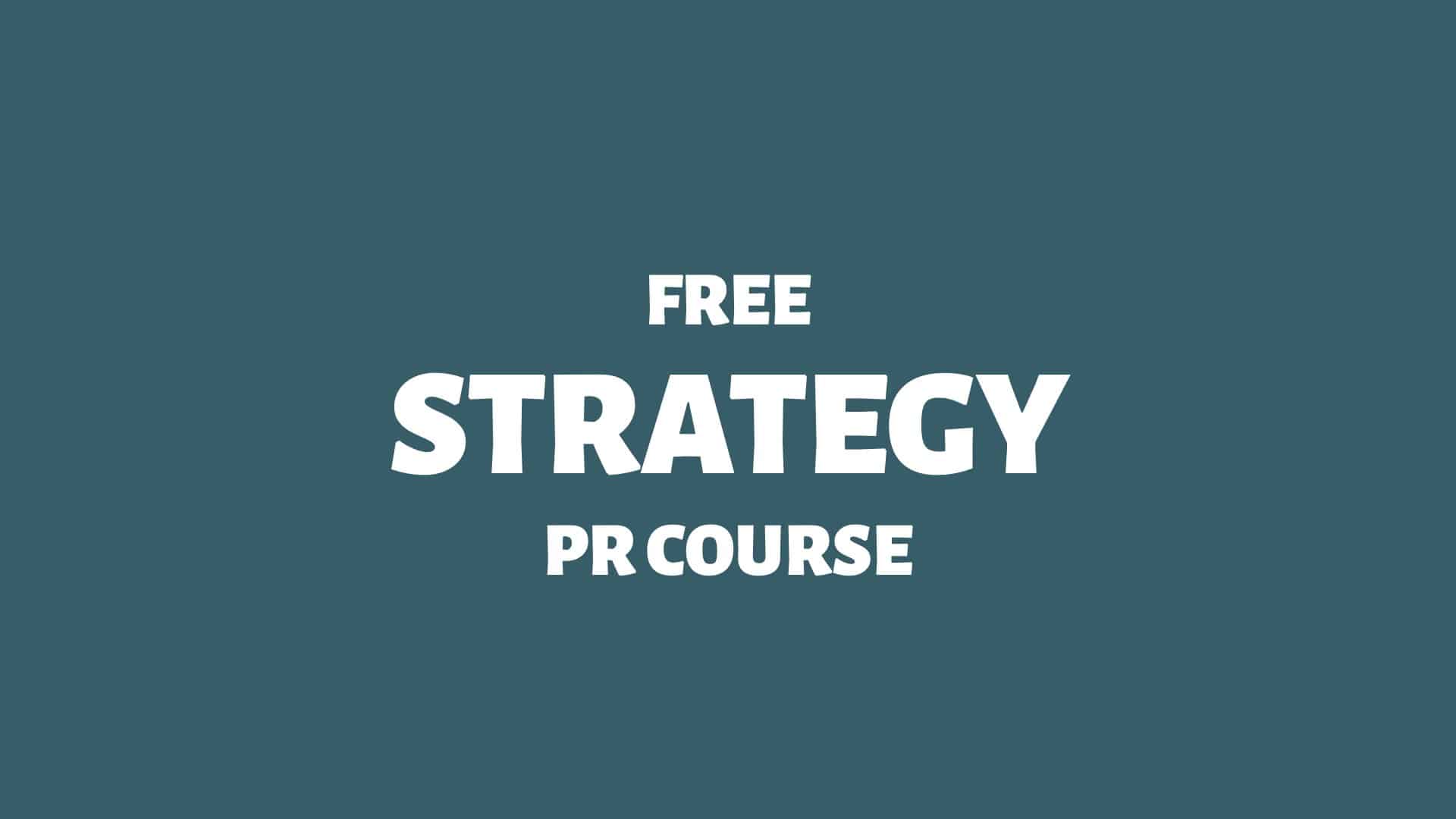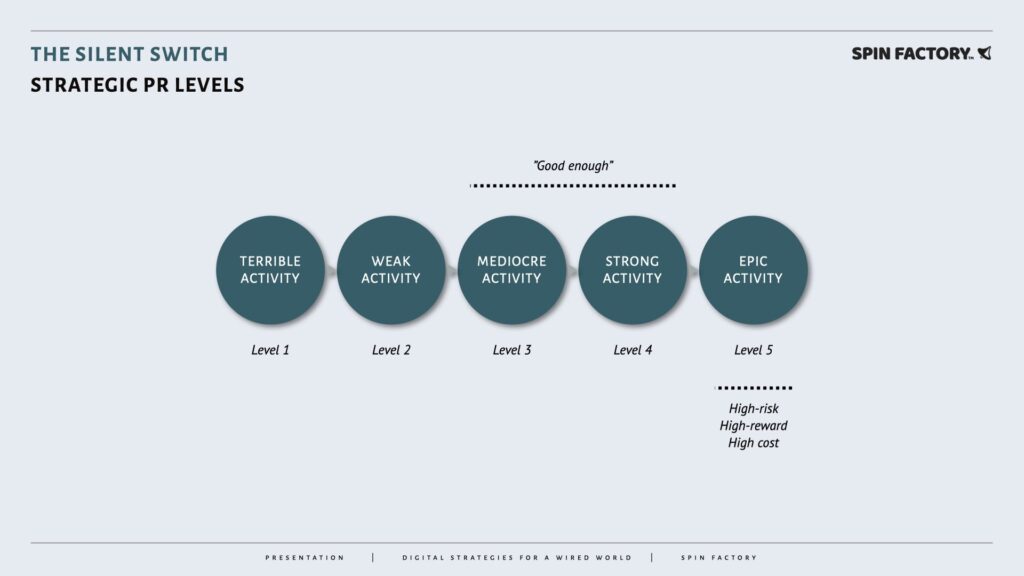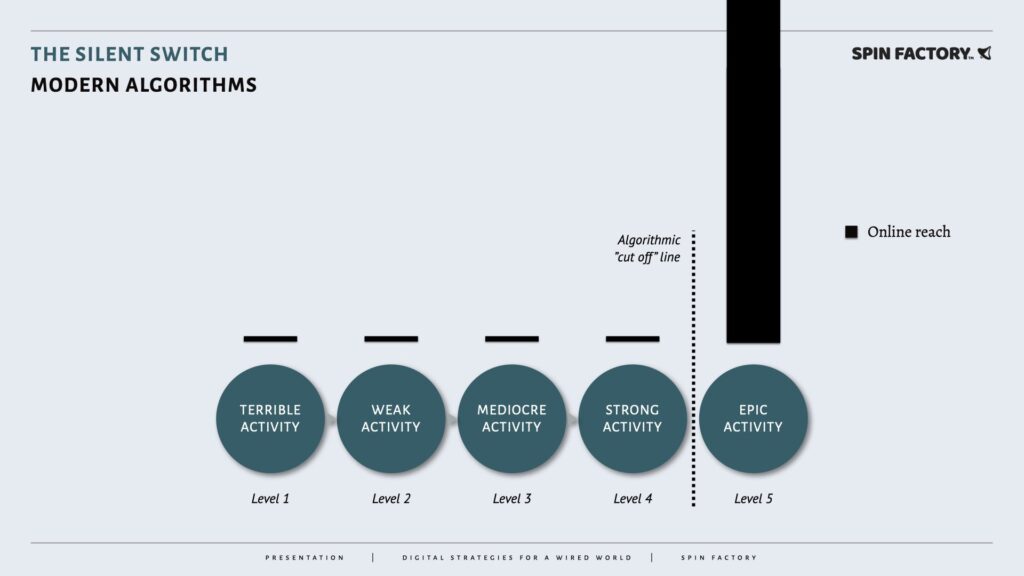What are level 5 PR activities — and why are they important?
In this article, I’ll briefly explain how search engines and social media algorithms are sorting away mediocre and strong PR activities.
I’ve been advising clients on digital strategies for two decades. The short version: What used to work yesterday probably won’t work today.
Today, you might have to go big — or go home.
Here we go:
“Level 5”
Think of the arbitrary quality of PR activities in five levels—from terrible to epic.
No one wants terrible or weak PR activities, but in some scenarios, producing a steady stream of average and good PR activities over time makes sense. They’re good enough, timely—and typically cost-efficient.
However, as the competition for attention becomes more intense, publics cares less and less about mediocrity.
To make matters worse, search engines and social media algorithms are getting better by the day at sorting away anything that isn’t epic (i.e. the silent switch).
Depending on the industry, the bar for what will cut through the noise of a digital-first landscape has become insanely high. Oftentimes, good isn’t good enough anymore.
What does this mean for public relations?
The apparent solution is epic PR activities (“level 5”). It means only going for enormous scales or unfathomable creative PR ideas every time. Go big — or go home.
A level 5 PR strategy guarantees exposure and word-of-mouth, but the investment requires considerable time, talent, and money. This is not a PR strategy for the faint-hearted.
Now, if budgets and creatives aren’t in endless supply, the redeeming resource here is time.
Therefore, the level 5 PR strategy often involves lessening the number of PR activities and focusing all PR resources on one big splash.
Learn more: The Level 5 PR Strategy
Examples of Level 5 PR Activities
Here are examples of epic PR activities (“level 5”) where organisations went all in on one spectacular campaign to dominate public attention:
Each PR activity exemplifies a level 5 PR strategy — high-risk, high-reward, and high-cost.
Learn more: The Level 5 PR Strategy
The Silent Switch
All social media algorithms are built differently and are constantly being developed. At the same time, social media users’ behaviours are evolving.
Still, there was a way that social media algorithms used to behave—and there is a way that social media algorithms behave now.
This has been a fundamental but silent switch.
How Social Media Algorithms Used To Behave
For more than a decade, social media algorithms would deliver organic reach according to a distribution that looked something like this:
This distribution of organic reach enabled organisations to use social media despite not being “media companies.”
How Social Media Algorithms Behave Today
Today, after the silent shift, social media algorithms deliver organic reach more like this:
The increased competition and sophistication among content creators partially explain this new type of distribution. However, going viral is still just as possible for anyone.
How does this work?
The Single Content Algorithm
How can a social network predict what users will like?
Content from a trusted creator trusted by a large community of followers used to be the leading indicator of future performance. But today, social networks have found a better way to predict content success.
The single content algorithm = when social networks demote content creator authority to promote single content performance to maximise user engagement for ad revenue.
The single content algorithm presents newly published content to a limited audience sample size:
If the newly published content tests successfully, the social media algorithm pushes that content to a slightly larger statistical subset. And so on.
This iterative process means that single pieces of content worthy of going viral will go viral, a) even if it takes a longer time, and b) regardless of the content creator’s number of followers.
Learn more: The Silent Switch
Go For Level 5 — or Go Home
Today, we need strategies based on what’s rapidly becoming the most valuable commodity in the world — attention.
A critical point is that good enough PR activities will steal resources from potentially epic ones — whatever that may entail in your niche.
To paraphrase business author Jim Collins, “good can be the enemy of great.”
In the age of algorithms, the winners take all — or at least most of it. Traffic. Conversions. Engagement. Share of voice. Attention.
If this means producing less good content to make the occasional great content — so be it.

THANKS FOR READING.
Need PR help? Hire me here.

What should you study next?
Spin Academy | Online PR Courses

Spin’s PR School: Free Strategy PR Course
Unlock the power of strategic public relations with this free Strategy PR Course. Elevate your skills and boost your career today.
Public Relations Strategy 101
Public Relations Strategies
Grey-Hat PR Strategies
Learn more: All Free PR Courses
💡 Subscribe and get a free ebook on how to get better PR.







